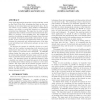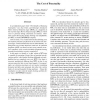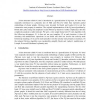1507 search results - page 186 / 302 » Separating Complexity Classes Using Structural Properties |
WEBDB
2005
Springer
14 years 3 months ago
2005
Springer
Large-scale information integration, and in particular, search on the World Wide Web, is pushing the limits on the combination of structured data and unstructured data. By its ver...
LICS
2007
IEEE
14 years 4 months ago
2007
IEEE
In an influential paper titled “The Benefits of Relaxing Punctuality” [2], Alur, Feder, and Henzinger introduced Metric Interval Temporal Logic (MITL) as a fragment of the r...
ITSSA
2006
13 years 10 months ago
2006
: The software industry is faced with the fast growing complexity of IT infrastructures. This makes manual administration increasingly difficult and appears to be the limiting fact...
BIBM
2007
IEEE
14 years 4 months ago
2007
IEEE
We analyzed the structural properties and the local surface environment of surface amino acid residues of proteins using a large, non-redundant dataset of 2383 protein chains in d...
COCOON
2001
Springer
14 years 2 months ago
2001
Springer
A data structure called PC-tree is introduced as a generalization of PQ-trees. PC-trees were originally introduced in a planarity test of Shih and Hsu [7] where they represent par...



